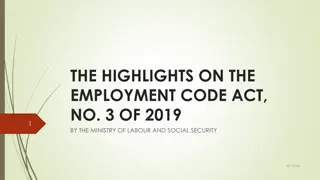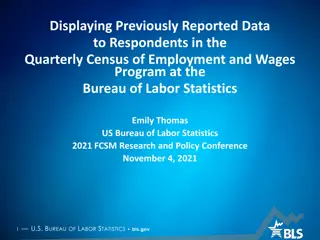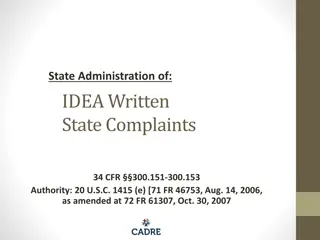Understanding Federal Employment EEO Complaints Process
Federal Employment EEO Complaints involve issues of unlawful discrimination, retaliation, and hostile work environments for federal government employees. This process covers bases such as race, color, national origin, sex, age, disability, and religion. Timeliness is critical, with contact required within 45 days of an incident. It's essential to differentiate between EEO complaints and other forms of grievances. Real-life examples highlight the challenges in proving discrimination. Proper documentation and understanding of the process are key to effectively navigating EEO complaints.
Download Presentation

Please find below an Image/Link to download the presentation.
The content on the website is provided AS IS for your information and personal use only. It may not be sold, licensed, or shared on other websites without obtaining consent from the author. Download presentation by click this link. If you encounter any issues during the download, it is possible that the publisher has removed the file from their server.
E N D
Presentation Transcript
Federal Employment EEO Complaints Bonney, Allenberg, O Reilly, & Eddy, P.C. 4854 Haygood Rd., Suite 200 Virginia Beach, VA 23455 Tel: (757) 460-3477 Fax: (757) 460-5387 Website: http://baofedlaw.com We are also on Facebook!
EEO Complaints Overview Who/What is Covered? Available to ANY federal government employee Complaints of unlawful discrimination BASED ON race, color, national origin, sex, age, disability, religion, and/or retaliation for protected EEO activity Note: Hostile Work Environment / Harassment are not protected BASES! When an employee tells you they want to file an EEO complaint for hostile work environment, always ask the follow-up question: A hostile work environment BASED ON WHAT? Note: Retaliation as a basis for an EEO complaint ONLY covers retaliation for protected EEO activity (such as having a prior EEO complaint or opposing discrimination in the workplace). If an employee is alleging retaliation for any other reason (such as retaliation for Union activity or for complaining about unsafe work practices), this is NOT grounds for an EEO complaint!!!
EEO Complaints: Timeliness Initiate contact with an EEO counselor within 45 calendar days of the discriminatory incident But what about complaints of a hostile work environment? Individual has to file within 45 days of the MOST RECENT incident.
Problems with EEO Complaints EEO should be treated as the FORUM OF LAST RESORT! If a successful grievance can be filed instead of an EEO complaint on a particular issue, file as a grievance instead of EEO! EEO complaints are ALWAYS the most difficult type of case to prove, as the burden is on the Complainant to prove not only that the Agency s action was wrong, but that it was wrong for discriminatory reasons! Discrimination is VERY DIFFICULT to prove!
Problems with EEO: Example Real-life example: A USPS bargaining-unit employee filed an EEO complaint based on retaliation for his prior EEO activity when he was not selected for a promotion. All of the panel members and the selecting official testified that they had no knowledge of the complainant s prior EEO activity. It was undisputed that the reason the complainant was non- selected was due to the fact that he had a prior on- the-job injury that was accepted by OWCP. The USPS disqualified his application due to his accident history. Federal employers are prohibited from retaliating against employees for filing OWCP claims (29 C.F.R. Section 1904.36). The accident scoring criteria violated that regulation.
Example (contd) The complainant should have filed a grievance through his Union for the agency violating 29 C.F.R. Section 1904.36, which would have been incorporated into the collective bargaining agreement. However, the complainant missed his deadline to file a grievance and instead filed an EEO complaint. In dismissing the complaint on summary judgment, the EEOC Administrative Judge noted that the Agency s procedures used to disqualify the complainant were erroneous, and that had the complainant not been disqualified for his OWCP activity he would have been promoted to the position. However, because the complainant could not prove that the non-selection was based on retaliation for EEO activity, the Judge ruled against the complainant, finding no discrimination.
EEO Complaint Process: Informal/Counseling Stage & ADR If the employee initiating the EEO complaint is a covered dues- paying Union member, have the employee designate a Union steward to be the employee s personal EEO representative at the Informal and Formal stages of the EEO process. Once the employee initiates complaint, the EEO counselor will typically ask the employee if he/she would like to participate in mediation (sometimes called Alternate Dispute Resolution or ADR ) or if he/she would prefer to go the traditional EEO processing route. If given the option for mediation, it is always up to the employee whether he/she would like to participate in mediation. In my experience, I have found that mediation often ends up being a waste of time that merely serves to delay case processing. However, for smaller- scale EEO complaints (complaints that do not involve a large amount of back pay or damages), mediation can sometimes be successful in resolving a case by getting a written settlement agreement early on in the process, rather than litigating the complaint all the way through the very lengthy EEO process).
EEO Complaint Process: Informal/Counseling Stage If the employee elects the traditional (no mediation) EEO processing route, or if the employee goes to mediation and the mediation is not successful (there is no settlement entered), the employee will eventually get a Notice of Right to File Formal Complaint of Discrimination. The employee needs to bring ALL incidents he/she wants to have included in the EEO complaint to the attention of the EEO Counselor BEFORE filing his/her formal EEO complaint. The employee should receive his/her Notice of Right to File Formal within 30 days of initiating contact with an EEO counselor. However, this timeframe can be extended if the employee agrees to mediation. After receiving the Notice of Right to File Formal, the employee must file his/her formal EEO complaint within 15 calendar days.
EEO Complaint Process: Formal/Investigation Stage After filing formal complaint, the employee s EEO complaint will either be accepted, dismissed, or partially dismissed. A complaint can only be dismissed or partially dismissed for very limited reasons (such as untimeliness or failure to state a claim). As long as the EEO complaint is, in whole or in part, accepted, the accepted issues will be sent to an investigator to investigate the accepted issues. The investigation can be done by a number of different methods: Fact-finding conference (the most in-depth) Individual interviews (either in-person or telephonic) E-processing (answering investigator s questions via e-mail) The investigation MUST be completed within 180 days of the employee filing his/her formal complaint!!! If anyone asks for an extension to the 180-day timeframe, DO NOT GIVE THEM AN EXTENSION!
EEO Complaint Process: Formal/Investigation Stage Requesting Witnesses Complainant can request that the investigator speak to certain witnesses who will support his/her testimony. The most useful witnesses to request are people who have either first-hand knowledge of the relevant facts of the case, or who have first-hand knowledge of discrimination by the named discriminating official(s) in the case. The investigator is not obligated to collect testimony from someone just because they are listed as a witness. Any testimony collected by investigator from witnesses will be included in the Report of Investigation (ROI). Rebuttal Opportunity Once the investigator collects testimony from the discriminating official(s), the investigator provides the Complainant with that testimony and allows Complainant to submit a rebuttal statement. Complainant should write a rebuttal statement pointing out the untruths and/or false statements in the discriminating official s testimony. Complainant s rebuttal statement will be included in the Report of Investigation.
EEO Complaint Process: Amendments After initiating an EEO complaint, sometimes an employee will continue to face additional discriminatory actions from the Agency. Employees have the right to amend their EEO complaints by contacting the EEO counselor with the additional incidents of discrimination. While amending a complaint is an employee s right, amendments always lead to delays in the EEO process, allowing the agency to extend their 180-day investigation period to up to 360 days. If you are representing an employee who has already filed a formal complaint of discrimination and wants to amend his/her complaint to add more issues, call the Union attorneys before amending the complaint!!!
EEO Complaint Process: Hearing Stage Within 180 days of the date the employee filed his/her formal complaint, the employee should receive a Report of Investigation (ROI) containing the evidence and testimony collected by the investigator. Along with the ROI, the employee should also receive notice of his/her right to file a request for hearing before an EEOC Administrative Judge (AJ). If the employee designated a Union rep as his/her personal EEO representative during the investigation stage, the designated rep should also receive a copy of the ROI when it is issued. CONTACT UNION ATTORNEYS AND PROVIDE US WITH A COPY OF THE ROI FOR REVIEW AS SOON AS YOU RECEIVE IT!!!
EEO Complaint Process: Hearing Stage Employee has 30 calendar days from the date of receiving the ROI to file his/her hearing request. Even if the employee has not yet received his/her ROI, if 180 days have passed since filing the formal complaint, he/she still has the right to request a hearing. AS A RULE OF THUMB, ALWAYS CALL THE UNION ATTORNEYS ONCE 180 DAYS PASS FROM THE FILING OF FORMAL COMPLAINT!!! Once a hearing is requested, an AJ will be assigned to the case and will send various orders requiring additional information, scheduling conferences, and setting deadlines. These Orders are IMPORTANT!
EEO Complaint Process: Hearing Stage The Hearing Process for EEO complaints is LONG and can take YEARS to get a decision!!! After Discovery concludes, the EEOCAJ will eventually issue a Hearing Order, scheduling a hearing on the case, UNLESS the case is dismissed on Summary Judgment . Summary Judgment is a ruling in which the AJ makes a decision in favor of either party on the record, without requiring a hearing. Summary Judgment is only permissible if no material facts are in dispute in the case. A Hearing is like a trial, where both sides can call and cross-examine witnesses and produce exhibits to be entered into the record. Most EEO hearings last 1-3 days, and usually take place either at the agency s facility or at the applicable EEOC district office. Due to the COVID-19 pandemic, most EEO hearings are currently taking place virtually, via Zoom or Microsoft Teams. After the hearing, the AJ will issue a written decision, either finding that the employee was discriminated against, or finding that the Agency did not discriminate against the employee.
EEO Complaint Process: Appeal After receiving a decision from the AJ, the Agency is required to issue a Final Agency Decision (FAD), in which the Agency will either agree with and implement the AJ s decision, or disagree with and appeal the AJ s decision. If the FAD implements the AJ s decision, and if the AJ s decision found against the employee, the employee can file an appeal to the EEOC Office of Federal Operations (OFO) within 40 days of receiving the FAD. An OFO appeal is a written appeal process, with no right to an additional hearing. The OFO has NO TIME FRAMES on how long they can take to issue a decision on the appeal.
Remedies: EEO In removal/discipline cases: cancellation/ mitigation of the adverse action Retroactive backpay and benefits, with interest (if applicable) In non-selection cases, placement into the position or a substantially similar position Compensatory damages. This includes: Pecuniary damages (out of pocket damages, such as medical expenses); and Nonpecuniary damages (intangible damages emotional distress ) Statutory Cap of $300,000.00 in compensatory damages Compensatory damages are not available in reasonable accommodation cases where the Agency proves they tried to accommodate complainant in good faith.
Remedies: EEO (continued) Attorney s fees Posting for 60 days in conspicuous areas within the agency indicating the nature of the violation found and the specific relief awarded by the Commission EEO training for managers, supervisors, and other employees involved EEO Judges can recommend that the Agency consider disciplinary action for the responsible management officials, but very rarely do agencies carry out this recommendation.
Request for Reasonable Accommodation Employees can request reasonable accommodations for either their religion or disability. Disability means: 1. A physical or mental impairment that substantially limits one or more of the major life activities of such individual; 2. A record of such an impairment; or 3. Being regarded as having such an impairment. 42 USC 12102 (1). However, individuals who only are regarded as disabled are NOT entitled to reasonable accommodation.
Request for Reasonable Accommodation: The Process Reasonable Accommodation starts with a REQUEST! Employee must put agency on notice that she has a disability for which she is requesting accommodation. No magic words necessary Does not have to be in writing, but written is preferred Can be made to supervisor or manager in chain of command, EEO office, or any other office designated to oversee accommodation process. Can request reasonable accommodation in the form of Job Restructuring or Reassignment. Reassignment is the Accommodation of LAST RESORT! Qualified individual with a disability is not necessarily entitled to preferred/requested accommodation if there is another accommodation Agency is willing to grant that will effectively accommodate employee.
Request for Reasonable Accommodation: The Process Employee s request for reasonable accommodation must be supported by adequate medical documentation. If Employee is seeking accommodation of a disability, she should not refuse to provide medical documentation based on violation of my HIPAA rights or violation of the Privacy Act or any other reason. The Agency has a right to request and receive relevant medical documentation regarding the nature, severity and duration of the impairment; the activities that the impairment limits and the extent to which those activities are limited; and why the employee requires reasonable accommodation. Job Accommodation Network (JAN) is a good place to get ideas for possible reasonable accommodations to request. www.askjan.org























